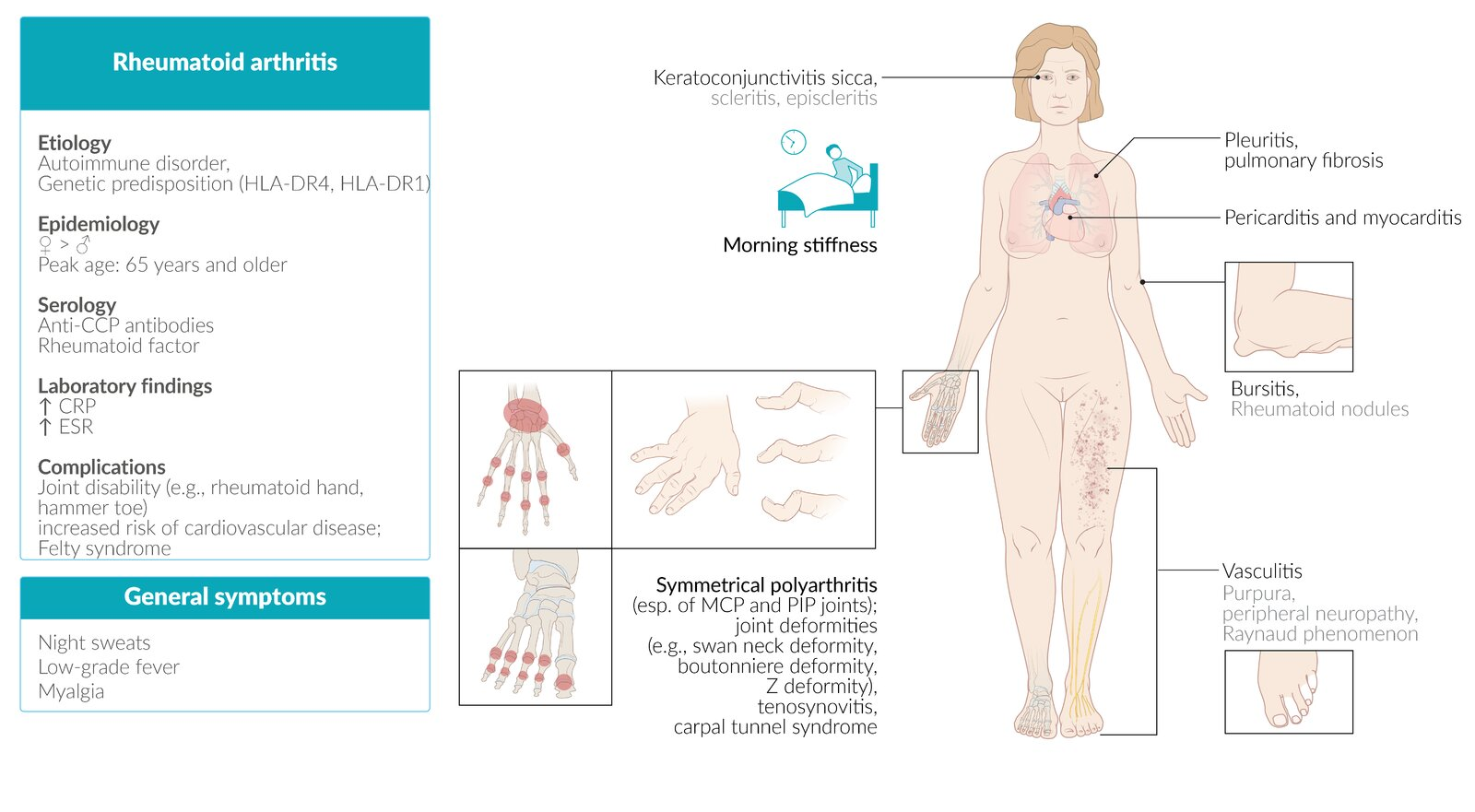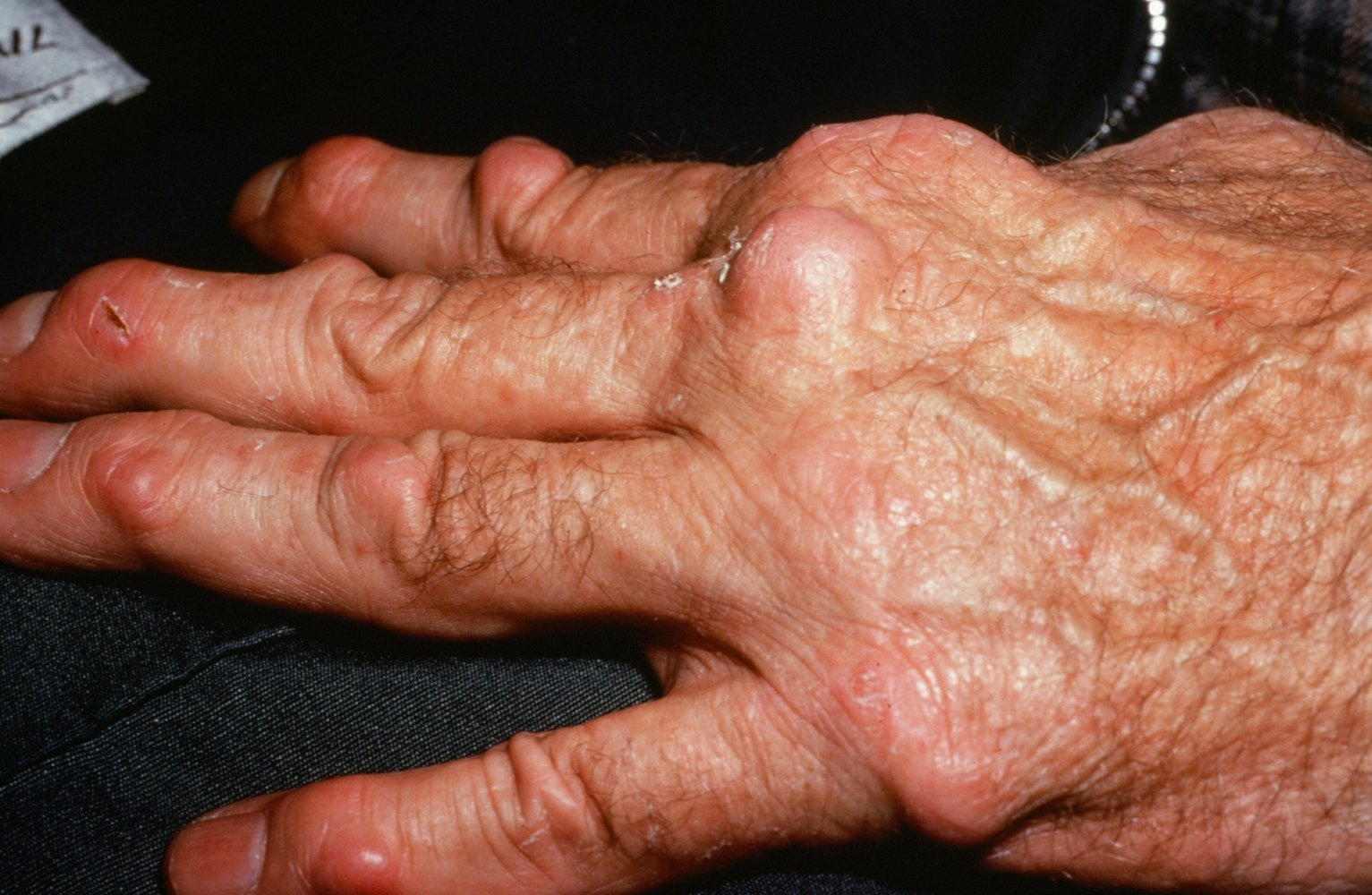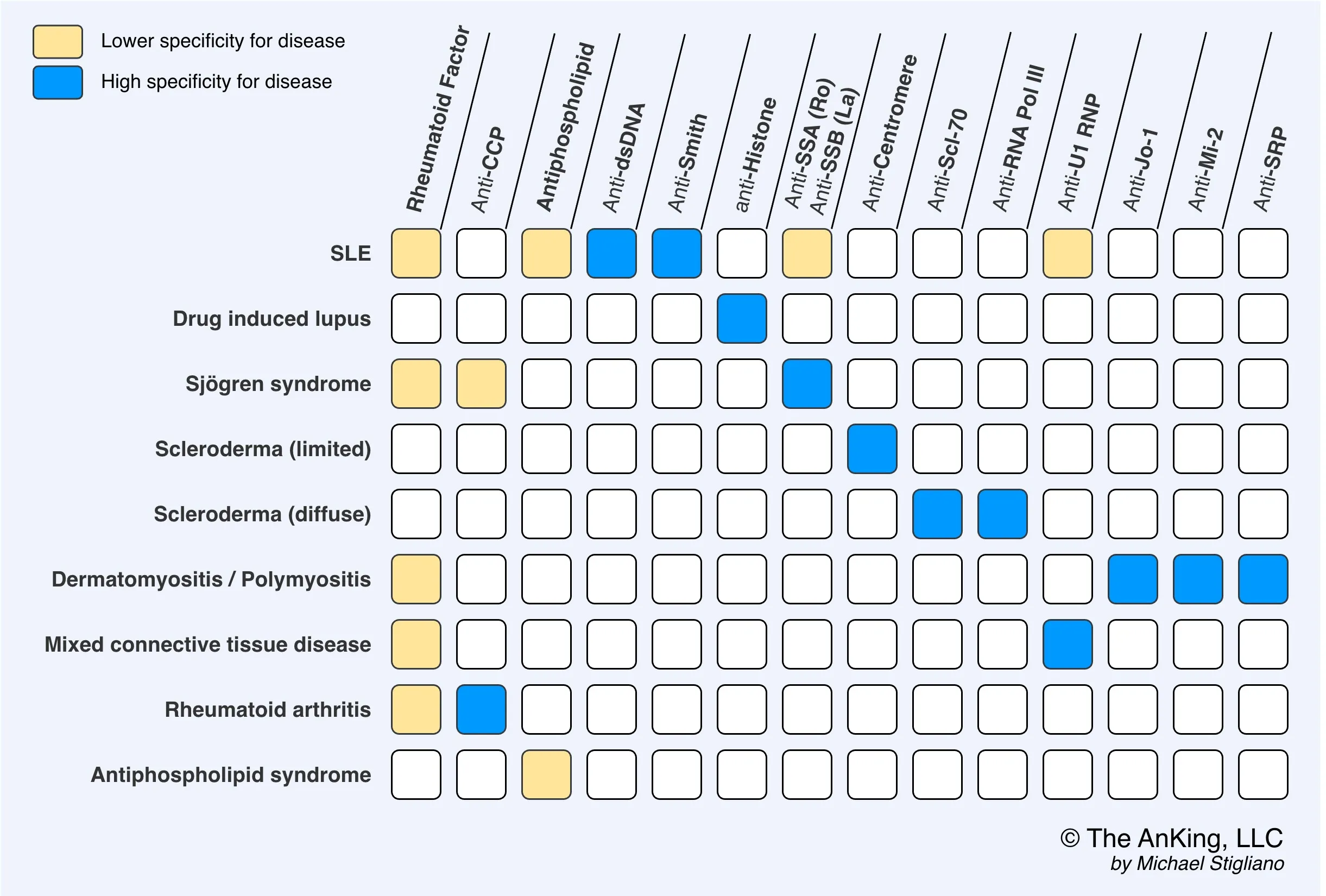Epidemiology
Etiology
- Idiopathic inflammatory autoimmune disorder of unknown etiology
- Risk factors include:
- Genetic disposition: associated with HLA-DR4 and HLA-DR1
- Environmental factors (e.g., smoking)
- Hormonal factors (premenopausal women are at the highest risk, suggesting a predisposing role of female sex hormones)
Pathophysiology
- Core Concept: A systemic autoimmune disease triggered by an environmental factor in a genetically susceptible host, leading to chronic synovial inflammation and joint destruction.
- Initiation
- Genetics: HLA-DR4 is the key association.
- Triggers: Smoking is the most significant environmental risk factor.
- Mechanism: Triggers cause citrullination of self-antigens, creating neoantigens targeted by the immune system.
- Key Immune Components
- TH cells (CD4+): The central drivers. They activate B-cells and macrophages.
- B-cells: Produce autoantibodies:
- Rheumatoid Factor (RF): IgM antibody against the Fc portion of IgG. Low specificity.
- Anti-CCP: Highly specific antibody targeting citrullinated peptides.
- Macrophages: Release key pro-inflammatory cytokines.
- The “Big 3” Cytokines
- TNF-α, IL-1, and IL-6 are the primary mediators of inflammation and joint destruction. (High-yield for pharmacology).
- Joint Destruction Cascade
- Synovitis: Synovial lining becomes inflamed and hypertrophied.
- Pannus Formation: The inflamed synovium transforms into an aggressive a pannus (a mass of synovium, inflammatory cells, and granulation tissue).
- Erosion: The pannus invades and destroys adjacent cartilage (via MMPs) and bone (via RANKL-mediated osteoclast activation).

Clinical features

- Articular (Joints):
- Symmetric polyarthritis: Hallmark feature.
- Joints involved: Typically affects small joints of the hands and feet, such as the metacarpophalangeal (MCP), proximal interphalangeal (PIP), and metatarsophalangeal (MTP) joints, as well as the wrists.
- Morning stiffness: Lasts >1 hour and improves with activity (unlike osteoarthritis).
- Spared joints: The distal interphalangeal (DIP) joints are typically spared.
- Deformities (late-stage): Ulnar deviation of fingers, swan-neck deformity (PIP hyperextension, DIP flexion), and Boutonnière deformity (PIP flexion, DIP hyperextension).
- Extra-articular Manifestations:
- Constitutional: Fever, fatigue, weight loss, and malaise are common.
- Rheumatoid Nodules: Most common extra-articular finding; firm, subcutaneous nodules over extensor surfaces or pressure points.

- Pulmonary: Interstitial lung disease, pleuritis, and pulmonary nodules.
- Cardiovascular: Increased risk of premature atherosclerosis and coronary artery disease; pericarditis.
- Hematologic: Anemia of chronic disease, thrombocytosis.
- Ocular: Scleritis, episcleritis, and secondary Sjögren’s syndrome.
Subtypes and variants
Atlantoaxial subluxation (Vertebral subluxation)
- Definition: a potentially life-threatening complication caused by the inflammatory destruction of the ligaments affecting the atlantoaxial joint and the intervertebral joints
- Clinical features
- Pain and stiffness of the neck (typically early-morning neck pain at rest)
- Head tilt
- Neurological deficits
- Cervical radiculopathy with peripheral paresthesias of the upper limb
- In some cases, symptoms of high spinal cord compression
- Slowly progressive spastic quadriparesis
- Hyperreflexia or positive Babinski reflex
- Respiratory insufficiency
- Diagnostics
- Extension and flexion x-rays of the cervical spine
- MRI
Warning
Endotracheal intubation can acutely worsen the subluxation and cause compression of the spinal cord and/or vertebral arteries.
Diagnostics

- Anticitrullinated peptide antibodies (ACPA), e.g., anticyclic citrullinated peptide (anti-CCP)
- Tissue inflammation causes arginine residues in proteins such as vimentin to be enzymatically converted into citrulline through a process called citrullination. This alters the shape of the proteins, which can then serve as neoantigens that generate an immune response.
- Rheumatoid factor (RF): IgM autoantibodies against the Fc region of IgG antibodies t
Differential diagnostics
- Parvovirus B19 will presents with similar symptoms, except for rash, normal ESR, and acute onset
- See Differential diagnosis
| Characteristic | Osteoarthritis (OA) | Rheumatoid Arthritis (RA) |
|---|---|---|
| Age of onset | >50 years | 30-50 years |
| Cause | ”Wear and tear” or trauma causing cartilage deterioration | Autoimmune inflammatory reaction against synovium |
| Primary joints affected | Weight-bearing joints (hips, knees), DIP, CMC of thumb | PIP, MCP, ankle, elbow, wrist; spares DIP Atlantoaxial subluxation |
| Joint characteristics | Hard and bony | Soft, warm, and tender |
| Pain pattern | Worse during or after activity | Worse in the morning or with inactivity |
| Stiffness | <30 minutes in morning, worse with activity | >30 minutes in morning, worse with inactivity |
| Joint symmetry | Often asymmetric, reflecting use patterns | Typically symmetric, diffuse involvement |
| Lab findings | Normal rheumatoid factor, normal anti-CCP antibody, normal ESR and CRP | Positive rheumatoid factor, positive anti-CCP antibody, elevated ESR and CRP |
| Associated signs | Heberden’s nodes (DIP), Bouchard’s nodes (PIP) | Ulnar deviation, boutonniere deformity, swan-neck deformity |
| Systemic involvement | None | Potential pulmonary and cardiac disease |
| Gender predilection | None | 2x more common in females |
| X-ray findings | Osteophytes, subchondral sclerosis, asymmetric joint space narrowing | Symmetric joint space loss, osteopenia, “apple coring” bone erosion |
| Exam findings | Effusion, tenderness | Effusion, tenderness, redness, warmth, synovitis |
Treatment
Acute anti-inflammatory treatment
- Glucocorticoids
- Systemic prednisone
- Longer-term therapy: Only use in patients with highly active RA
- Systemic prednisone
- NSAIDs and selective COX-2 inhibitors: relieve symptoms, but do not improve the prognosis
Long-term pharmacological treatment
Disease-modifying antirheumatic drugs (DMARDs)
- Methotrexate (MTX): first-line treatment in patients with moderate to high disease activity
- To minimize adverse effects, administer folic acid.
- Hydroxychloroquine: Consider in patients with low disease activity.
- Decreases complement-dependent antigen-antibody reactions
Biologic DMARDs
- Indication: persistent moderate or severe disease activity after 3 months of conventional DMARD therapy
- Agents
- TNF-α inhibitors: e.g., adalimumab, infliximab, etanercept
- See Etanercept
- TNF-α inhibitors: e.g., adalimumab, infliximab, etanercept
Complications
- AA amyloidosis (secondary amyloidosis)
- Septic arthritis